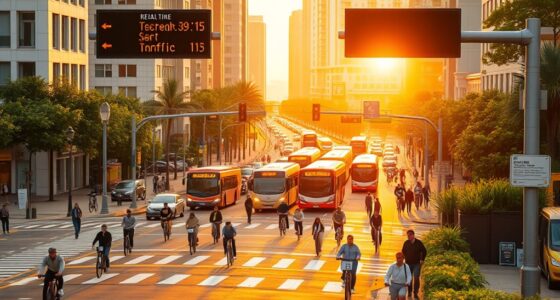Urban cycling's a thrilling adventure filled with personal stories of triumph and challenge. You'll face obstacles like traffic and inadequate lanes, but through it all, you'll bond with fellow riders and weave your unique narrative into the city's fabric. As you embrace the health and environmental benefits, you become part of a movement advocating for better infrastructure. Discover how your rides can transform not just your commute, but the community around you, as you navigate through these engaging tales.
Key Takeaways
- Many cyclists share stories of overcoming challenges like dangerous intersections and lack of bike lanes, highlighting the need for better infrastructure.
- Community cycling groups often host events that foster connections and create a sense of belonging among diverse riders in urban areas.
- Personal experiences of biking during the pandemic reveal how it became a vital source of exercise and mental well-being for many individuals.
- Successful bike-sharing programs in cities demonstrate how accessibility can transform commuting habits and reduce carbon emissions significantly.
- Cyclists frequently advocate for safer routes and enhanced bike lanes, showing the collective effort to improve urban cycling experiences.
The Daily Commute: A Cyclist's Journey Through the City
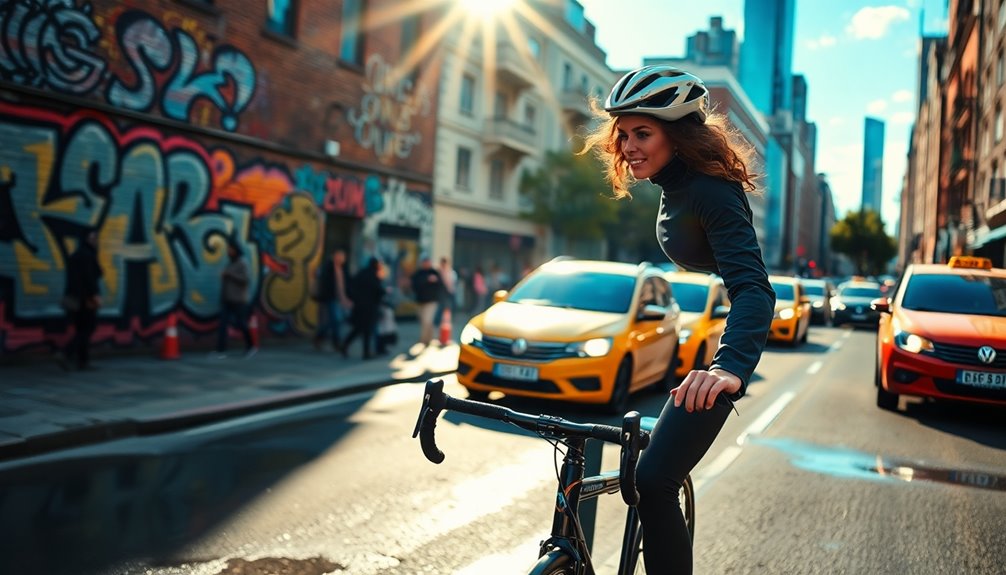
The daily commute on a bike transforms the way you experience the city. You feel the pulse of urban life as you glide past bustling cafes and vibrant parks, witnessing the city's rhythm up close.
With bike trips growing by 37% from 2019 to 2022, more people are discovering this enjoyable mode of travel. Major cities, accounting for 77% of bike activity, offer unique environments that cater to cyclists.
During the pandemic, you likely noticed an uptick in fellow riders, as many turned to biking for exercise and fresh air. Bike share programs like Citi Bike and Divvy made biking accessible to everyone. Additionally, the trend towards sustainable living practices encourages urbanites to choose biking over driving, reducing their carbon footprint in the process.
Overcoming Obstacles: Navigating Urban Cycling Challenges

While urban cycling offers a unique way to experience the city, navigating the challenges that come with it can be daunting.
You'll often find yourself contending with insufficient infrastructure—like the lack of segregated lanes and incomplete routes—putting you at risk with heavy traffic.
Poorly managed intersections can feel particularly hazardous, and the maintenance of bike paths might leave much to be desired.
Safety concerns are ever-present, from aggressive drivers to inadequate lighting.
Safety remains a crucial issue for urban cyclists, with aggressive drivers and poor lighting posing significant risks.
You might struggle with parking and theft worries, too, as secure bike spots are often scarce.
To make your ride smoother, consider planning routes that account for hills and road conditions, and stay updated on real-time traffic information to enhance your cycling experience.
The Joy of Community: Cycling Groups and Social Connections
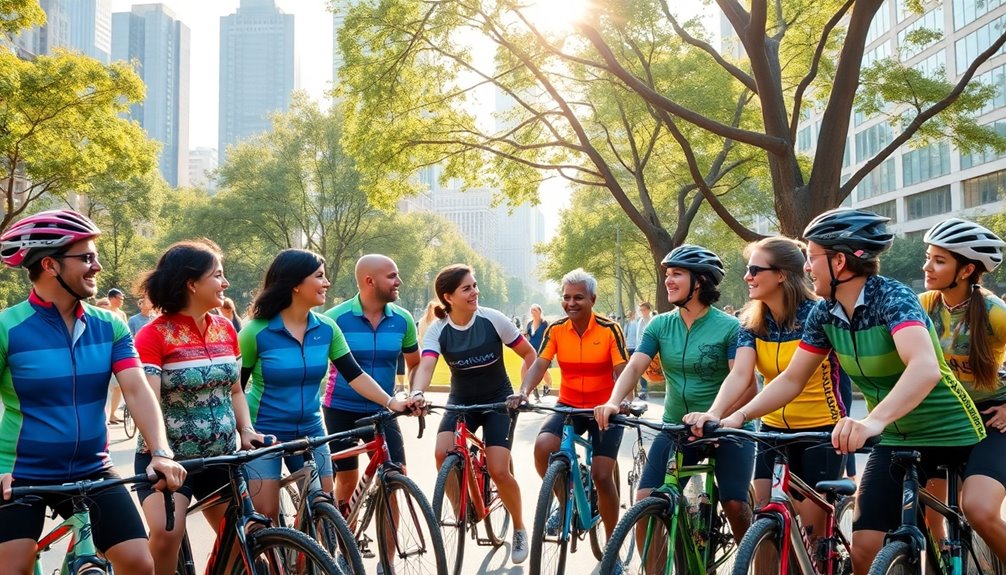
Connecting with others through cycling can transform your experience, making it not just about getting from point A to point B but also about building relationships and community.
Joining cycling groups allows you to meet diverse riders, from casual bikers in Washington, D.C., to the growing number of women in the Twin Cities. You'll find a mix of ages, with many cyclists aged 45-64, fostering connections across generations.
Community events and advocacy efforts strengthen local ties, turning cycling into a shared passion. Whether you're participating in a group ride or a local cycling event, these social interactions enrich your journey, making every ride a chance to connect, learn, and grow within your cycling community.
Safety First: Personal Stories of Urban Cycling Incidents

How can one truly grasp the risks of urban cycling without hearing firsthand accounts from those who've faced dangerous situations?
Picture yourself pedaling through a bustling city, and suddenly, a car speeds by, barely missing you. That's what happened to Sarah, who now insists on wearing reflective gear and using bright lights, especially at night.
Or think about Mark, who was hit at an intersection when a driver failed to yield. He survived but learned the hard way about the importance of helmet use and staying alert.
Incidents like these highlight the high fatality rates and dangers cyclists face daily.
It's crucial to advocate for better infrastructure and increased awareness to protect cyclists navigating urban roads.
Transformative Infrastructure: How New Bike Lanes Changed Lives

Urban cycling incidents underscore the pressing need for safer riding environments, which is where transformative infrastructure comes into play.
New bike lanes can significantly change your daily commute, making it safer and more enjoyable. They boost local economies by attracting businesses, increasing foot traffic, and even raising property values in your neighborhood.
As more people cycle, you'll notice a healthier community and reduced healthcare costs over time. Plus, these lanes improve air quality and reduce carbon emissions, contributing to a cleaner environment. Investing in energy-efficient systems helps further enhance urban sustainability alongside cycling infrastructure.
With cities investing in bike-friendly designs, like London's Vision for Cycling, you can expect vibrant public spaces that foster a sense of community.
Ultimately, new bike lanes not only enhance your ride but also enrich your urban experience.
From Skepticism to Advocacy: A Cyclist's Perspective
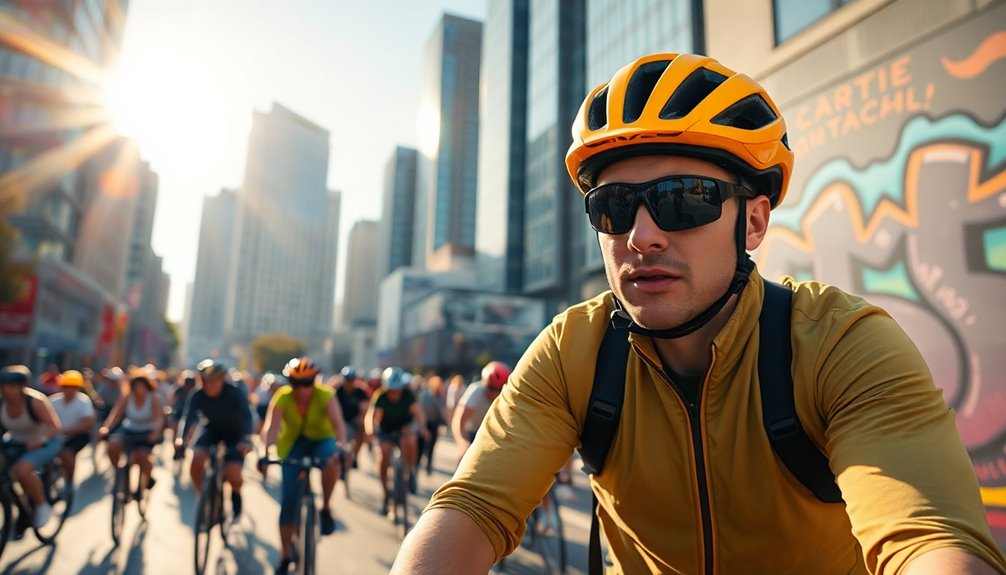
While many might initially view cycling as a fringe activity, the reality is that it's becoming a vital mode of transportation for countless individuals, particularly in underserved communities.
You might be surprised to learn that most cyclists in the U.S. come from lower-income backgrounds, challenging the stereotype of the urban hipster.
Safety concerns often cloud perceptions, but cities are increasingly investing in protected bike lanes, improving safety and connectivity.
Engaging low-income communities is crucial for effective advocacy; their voices must be heard in cycling initiatives.
Moreover, leveraging data-driven marketing strategies can enhance community awareness and support for cycling initiatives, ultimately fostering a more inclusive environment for all cyclists.
The Environmental Impact: Real Stories of Reduced Carbon Footprints
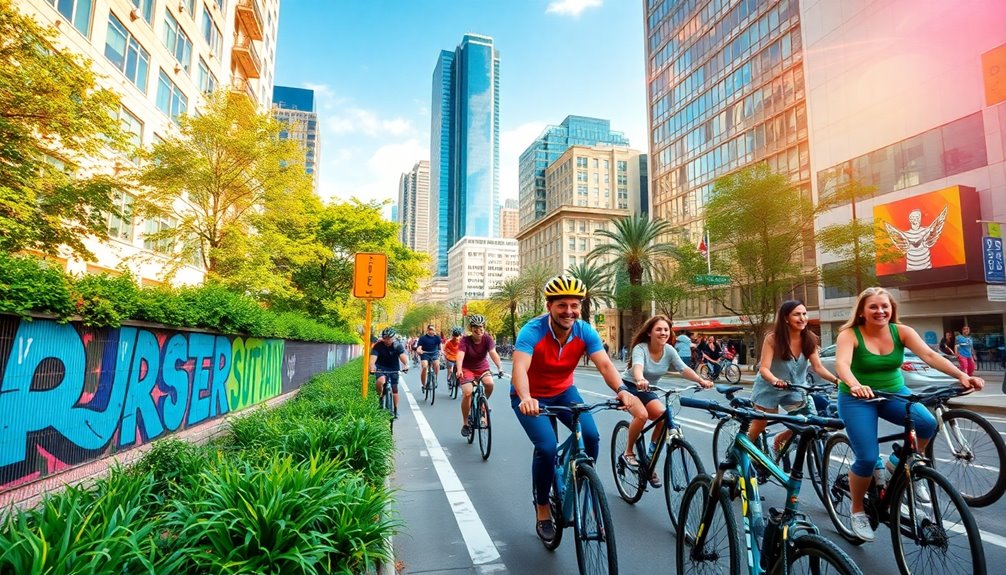
Cycling not only fosters community engagement and advocacy but also plays a significant role in reducing carbon footprints.
Imagine cycling just 10 km to work; you'd save around 1,500 kg of greenhouse gas emissions annually! If more people swapped short car trips for bicycles, we could dramatically cut global CO2 emissions.
Cities like Barcelona showcase how bike-sharing programs reduce CO2 by over 9,000 metric tons each year.
Plus, cycling boosts air quality, valued at over $90 million annually in places like Wisconsin.
With every pedal stroke, you contribute to cleaner air and less traffic congestion, making your city a better place.
E-Bikes and Their Impact: Embracing Technology for Urban Cycling
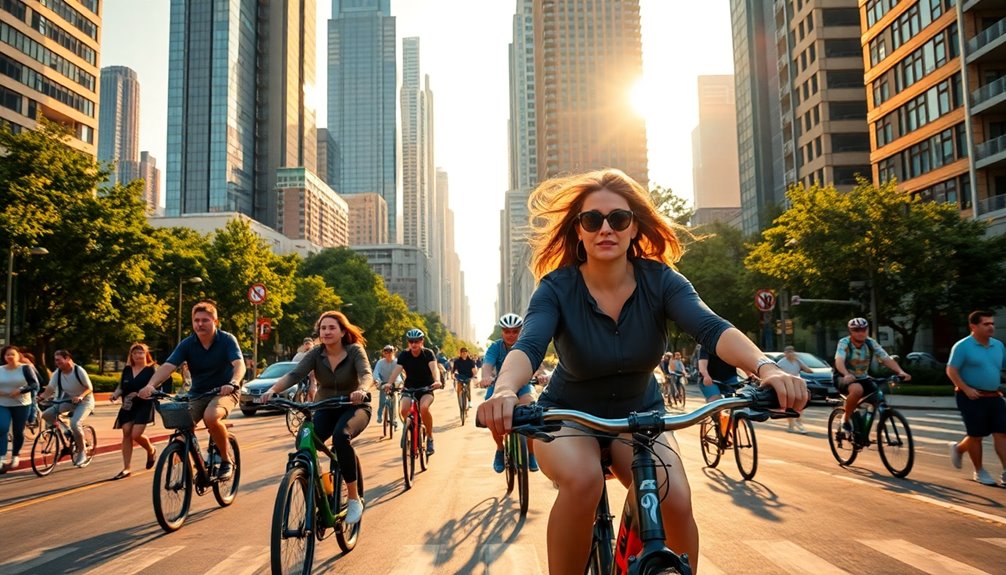
As cities evolve, embracing e-bikes has become a game-changer for urban transportation. The global e-bike market surpassed $40 billion in 2023 and continues to grow, with around 600,000 units sold in the U.S. back in 2020.
About 22.5% of riders use e-bikes for daily commutes, reflecting a significant shift. These bikes offer efficiency and convenience, allowing you to navigate congested streets faster while reducing physical exertion with their pedal-assist feature.
About 22.5% of riders now choose e-bikes for daily commutes, showcasing their efficiency and ease in navigating busy streets.
Cities are investing in bike-friendly infrastructure, making commuting smoother. Plus, e-bikes promote physical activity while being less strenuous than traditional bicycles.
With smart features and improved battery technology, e-bikes are paving the way for a sustainable, cost-effective urban mobility solution.
Frequently Asked Questions
What Are the Best Cities for Cycling Worldwide?
When you think about the best cities for cycling worldwide, consider Utrecht and Copenhagen. They lead with fantastic infrastructure and high cycling rates.
Amsterdam's vibrant cycling culture is also notable, even with some safety concerns.
Munster offers low accident rates, while Antwerp excels with bike-sharing systems.
Each city promotes cycling through community events and strong policies, making them ideal for anyone looking to ride comfortably and safely in urban environments.
How Do Cycling Habits Differ Between Urban and Suburban Areas?
Imagine gliding through a bustling city, the rhythm of life pulsing around you.
Cycling habits differ significantly between urban and suburban areas. In cities, you navigate bike lanes, face traffic, and reach destinations quickly.
In suburbs, the roads stretch longer, inviting leisurely rides through nature but often lacking dedicated paths.
While urban cycling emphasizes commuting and interaction, suburban cycling leans towards recreation and exploration, offering a different kind of freedom on two wheels.
What Are Common Misconceptions About Urban Cycling?
You might think urban cycling is just for elite athletes or that cyclists always break traffic laws, but that's not true. Most cyclists are everyday commuters enjoying the ride.
Many believe cycling is dangerous, but improved infrastructure can enhance safety significantly. Plus, you don't need to stick to bike lanes all the time.
Urban cycling's benefits, like reduced emissions and improved health, often get overshadowed by these misconceptions.
How Can Individuals Advocate for Better Cycling Infrastructure?
Imagine you're biking to work, dodging potholes and busy traffic.
You can advocate for better cycling infrastructure by organizing community rides to raise awareness. Share your experiences with local leaders to highlight the need for safe routes.
Collaborate with local businesses and nonprofits to build a coalition, and use social media to amplify your message.
Engage with your neighbors, encouraging them to voice their support for improvements that benefit everyone in your community.
What Role Do E-Bikes Play in Urban Cycling Trends?
E-bikes play a significant role in urban cycling trends by offering a convenient and eco-friendly transportation option.
You'll find they help you navigate congested streets effortlessly, making last-mile commuting a breeze.
With advancements in technology, e-bikes feature smart integrations that enhance your riding experience.
As cities invest in better cycling infrastructure, you can expect e-bikes to promote a cultural shift towards sustainable transportation, making urban mobility more accessible and enjoyable for everyone.
Conclusion
So, there you have it: urban cycling is like a high-stakes game of Frogger, but with more lycra and fewer frogs. You dodge cars, conquer potholes, and navigate bike lanes that sometimes seem like they're designed by a toddler with a crayon. Yet, amidst the chaos, you find camaraderie and a sense of purpose—saving the planet one wobbly ride at a time. Who needs a gym membership when you can battle traffic and call it exercise?



